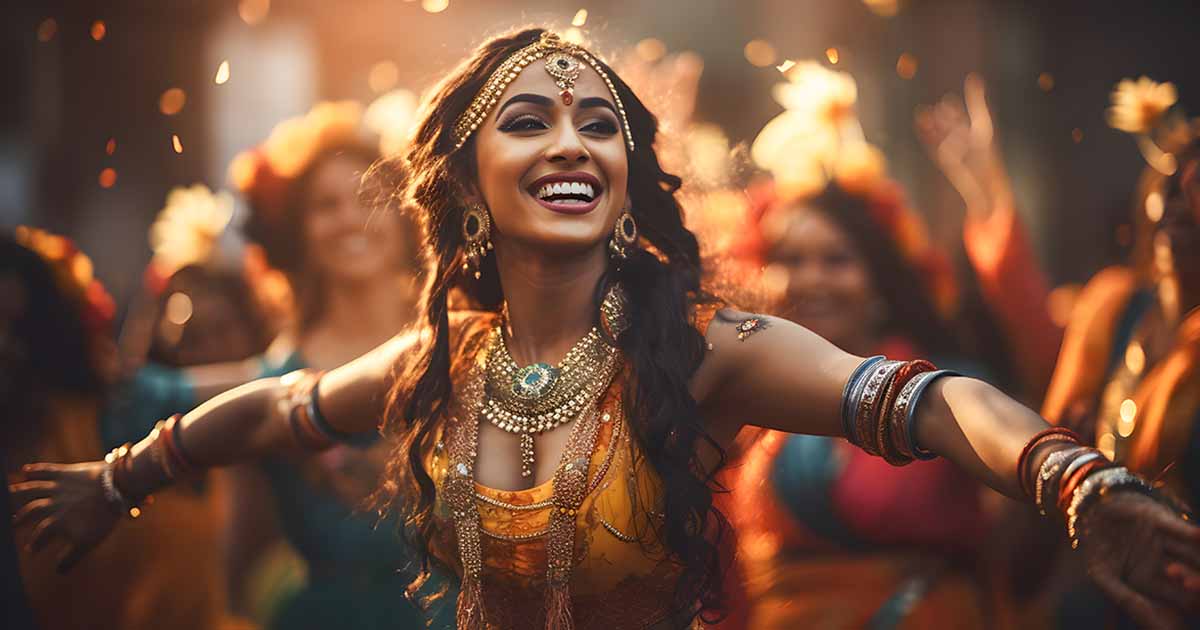Embracing the Divine: Eight Sacred Dances in Hindu Rituals
Sacred dance has always been an integral part of Hinduism, intricately woven into rituals and spiritual practices. The Vedas, the holy texts of Hinduism, intermingle performance arts with rituals, incorporating dramatic representations and discussions of spiritual themes.
Attributed to sage Bharata, the Hindu text Natyashastra is a seminal work that systematically presents the art of dance and performance. According to Natyashastra, dance is considered accomplished when it evokes a specific emotion ( rasa) among the audience, conveyed through precise gestures and facial expressions ( bhava).
The adherence to Natyashastra's guidelines defines a dance form as classical. Rooted in Hindu arts and religious traditions, these eight classical ritual dances of India exemplify the profound connection between dance and spirituality in Hinduism.
Sacred Dance #1: Bharatanatyam
The Bharatanatyam is one of the most ancient of the traditional Hindu sacred dances, dating back to around 1000 BC. It originates from the South Indian state of Tamil Nadu and today is mostly practiced by women.
The sacred dance is usually accompanied by traditional South Indian tunes called Carnatic music which consists of a lead vocalist joined by various traditional instruments like the veena (a stringed instrument), mridangam (a double-headed drum), ghatam (clay drum) and more.
Traditionally, Bharatanatyam is a solo dance performed only by women and is used to express Hindu religious themes and spiritual ideas, especially Shaivism, Vaishnavism and Shaktism. The dance is an embodiment of devotion, with each movement and gesture paying homage to the divine.
- Dance Macabre: How the Dead Danced with the Living in Medieval Society
- A Strange Ancient Dance with Unknown Origins – How Far Back Does the Morris Dance Really Go?
With its origins steeped in Natyashastra, the ancient treatise on the performing arts, Bharatanatyam is believed to have been gifted by Lord Brahma to the sage Bharata. The sacred dance evolved into its present form under the patronage of various dynasties and flourished within the temple precincts, serving as a medium of communication with the divine.
Unfortunately, like many other traditional Hindu dances, Bharatanatyam was suppressed during the colonial British Raj. It has only been in recent years, post-colonialism, that this beautiful sacred dance has seen a resurgence.
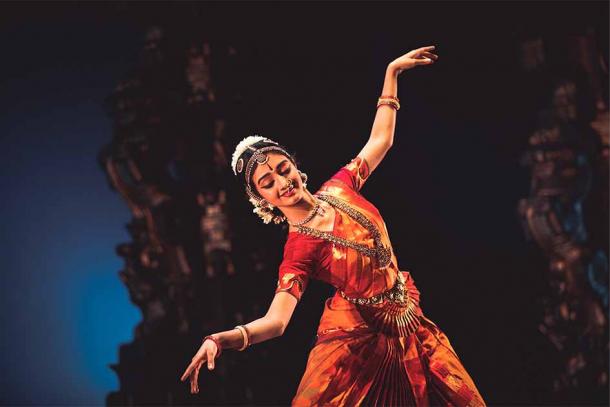
Graceful Bharatanatyam dancer. (JN / Adobe Stock)
Sacred Dance #2: Kathakali
Kathakali is a breathtaking mixture of dance and drama taking its name from the Hindu words katha (story) and kali (performance). Much younger than Bharatanatyam, it first appeared in Kerala, located in the southwest of India along the Malabar coast, in the 17th century.
Almost more like a play than a dance, the Kathakali stands out thanks to its elaborate, brightly colored makeup, costumes and masks, known as chutti, that adorn the dancers. In this case, the dancers tend to be all male and it’s believed the dance originally developed as performance art, used as a way to pass down Hindu myths and legends via dance, rather than orally. Often the performances are based on episodes from the Indian epics, Ramayana, and Mahabharata.
Kathakali itself might be a relatively recent addition to the Hindu ritual dances but its origins can be traced back much further. In particular, the sacred dance takes inspiration from the temple and folk arts like Kutiyattam (a traditional Sanskrit theatre form and one of the oldest in the world) and religious dramas going all the way back to the first millennium AD. Not just a mixture of dance and play, performers also incorporate elements of ancient south Indian martial arts like Kalaripayattu and Silambam into the dance as well as elements of local athletic traditions.
Another area in which Kathakali stands out is that unlike in some of the older ritual dances, the dancers purely focus on the choreography and are not expected to do double duty as vocal artists. The performances are typically held in open-air theaters called koothambalams, enhancing the experience by allowing the audience to witness the intricate details of the performances up close.
Sacred Dance #3: Kathak
Kathak takes its name from the Sanskrit word Katha, which as we mentioned above means story. It’s unsurprising then that it is usually attributed to ancient northern India’s traveling bards, the Kathakars, or “storytellers” in English.
Kathak evolved over time by incorporating two very different types of stories. Some Kathak dances retell traditional childhood stories, while others recount the amorous exploits of the Hindu god Krishna. Originally these dances would have only been held in the fanciest of temples and northern royal Mughal courts, where they integrated elements of Persian arts.
Over the years Kathak has transitioned from being a form of worship to a cherished art form held on prestigious stages. It has also evolved into three distinct forms, named after the cities where the sacred dance originated—Kapiur, Benares and Lucknow.
The movement of the sacred dance itself emphasizes rhythmic foot moments with the feet adorned with small bells called Ghungroo. These movements are harmonized with the music while the dancer’s legs and torso should largely remain straight.
The story of the dance is told through the Nritya aspect of the dance. Spins, footwork, arm movements and facial expressions ( abhinaya) form a type of wordless grammar used to convey a myriad of emotions, from love and devotion to joy and sorrow. In modern times, Kathak has embraced contemporary influences while preserving its classical foundations, making it a dynamic and evolving dance form that continues to inspire and enthrall audiences globally.
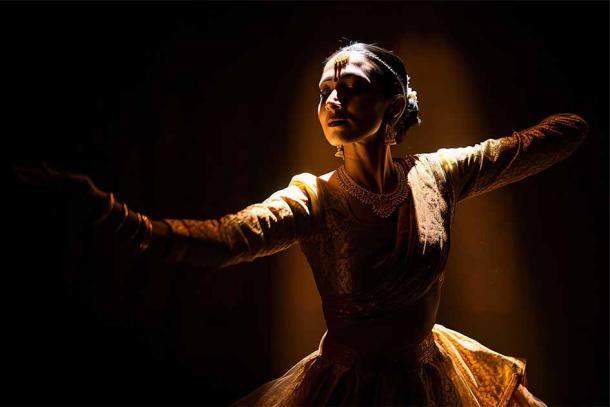
Kathak dancer performing sacred dance. (artem / Adobe Stock)
Sacred Dance #4: Kuchipudi
The origins of Kuchipudi are similar to that of Kathak in that it originally developed as a religious art linked to traveling bards who would move from temple to temple. Its direct origins can be traced back to the Krishna district of what is today, Andhra Pradesh.
Traditionally the performers of this sacred dance were all men, typically Brahmin (the priestly class and teachers of Hinduism’s caste system). The Brahmin would play the roles of both men and women, dressing accordingly.
The sacred dance mainly started out as a Krishna-orientated Vaishnavism tradition and is mostly closely related to the Bhagavata Mela performance art of Tamil Nadu. The dance is divided into two distinct parts; pure dance, known as nritta, and expression, nritya. Like Kathak, the dance uses rhythmic gestures to create a kind of sign language, accompanied by vocalists and musicians playing Carnatic music. Today, this dance form has evolved and people of different castes—both men and women—perform the Kuchipudi.
Sacred Dance #5: Odissi
This dance hails from the Hindu temples of the eastern coastal state of Odisha. Unlike the above dances, historically it was performed by women and was used to express religious stories and spiritual ideas associated with Vaishnavism, as well as those related to other Hindu gods like Shiva, Surya and other Hindu goddesses.
Much like Kathakali, Odissi is a mixture of drama and dance where the musicians and dancers play out a mythical story, spiritual message or devotional poem derived from Hindu texts. Dancers of Odissi embody various characters, often portraying episodes from Hindu mythology, especially focusing on the divine love between Radha and Krishna. The dance style is characterized by its delicate Tribhangi stance, where the body takes graceful poses with three bends, adding a distinct lyrical quality to the movements.
Accompanied by soul-stirring melodies of traditional Odissi music, including “Mardala” and “Manjira,” the dance reverberates with spiritual fervor, transporting audiences into a realm of divine ecstasy. The exquisite hand gestures known as “Mudras” and the elaborate “Abhinaya” expressions further enrich the performances, evoking a range of emotions.
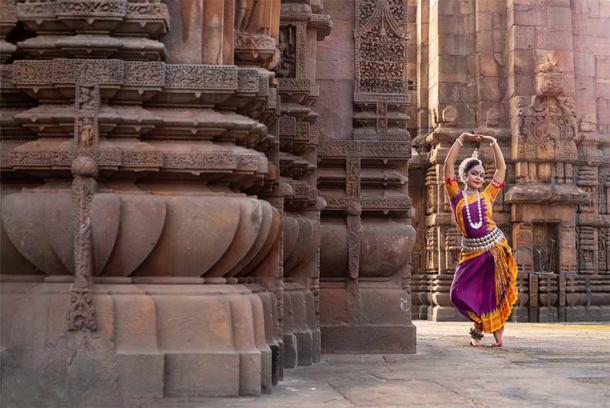
Odissi sacred dance is used to express religious stories and spiritual ideas associated with Vaishnavism. (ShaikhMeraj / Adobe Stock)
Sacred Dance #6: Sattriya
Sattriya is often attributed to one 15th-century Bhakti movement scholar and saint, Srimata Sankardev. Another classical dance-drama performance art, it is tied to the Krishna-centered Vaishnavism monasteries of Assam.
With its origins in the 15th century, Sattriya was nurtured within the sacred walls of sattras, the Vaishnavite monasteries. Originally performed exclusively by male monks, the sacred dance artfully conveyed stories from the life of Lord Krishna, focusing on his divine play and love. Over time, Sattriya transcended its monastic confines, evolving into a celebrated classical dance open to all.
Performances usually take the form of one-act plays called Ankiya Nat which combine the aesthetic and the religious through a mixture of ballad, dance, and drama. In the mid-20th century, Sattriya received formal recognition as a classical dance, garnering appreciation and attention from a broader audience.
Sacred Dance #7: Manipuri
Manipuri, sometimes referred to as Jagoi, takes its name from the region of its birth—Manipur—a northeastern state of India that borders Myanmar. With its origins tracing back to the Vaishnavite cult of Radha and Krishna, Manipuri is primarily devoted to depicting the celestial love stories of these divine beings.
The sacred dance is characterized by its graceful, fluid movements that emulate the delicate swaying of the lush landscapes and the gentle movements of Manipur's native Lai Haraoba festival.
Manipuri's distinctive features include the use of Ras Leela, a stylized group dance that reenacts the ethereal love between Radha and Krishna. The performers wear traditional, vibrant costumes ( Kumil) adorned with intricate embroidery, enhancing the visual splendor of the sacred dance.
Sacred Dance #8: Mohiniyattam
Another sultrier dance, Mohiniyattam, first developed in the state of Kerala and takes its name from Mohini. In Hindu mythology, Mohini was the seductress avatar of Vishnu who used her womanly charms to help holy soldiers prevail in a battle between good and evil.
Mohiniyattam follows the Lasya style laid out in the Natyashashtra. This means it is a more delicate dance made up of softer movements considered to be more feminine. Unsurprisingly when considering its origins, the dance is usually performed by a single woman who trains for years to be able to perfectly evoke Sringara Rasa, the sentiment of love and beauty.
- Candomble: The African-Brazilian Dance in Honor of the Gods
- The Reog Ponorogo: A Dance of Rebellion Which Changed History
The movements of the dancer are timed to soprana-styled music (a slower melody) while the vocalist recites songs that are typically in a Malayalam-Sanskrit hybrid called Manipravala. The Mohiniyattam is perhaps the most intimate and soul-stirring of all the traditional Hindu dances. Mohiniyattam unfolds like a poetic symphony, captivating spectators with its emotive grace. The dancer's expressive eyes and subtle smile accentuate the storytelling, enchanting audiences with every gesture and movement.
Bonus: The Three Dances of the Mysuru Festival
Every year Mysuru, a city in the state of Karnataka, India holds its grand and extravagant festival called Mysuru Dasara or simply Dasara. This is a ten-day-long festival celebrated with great pomp and fervor. One of the festival's biggest attractions is its three ritual dances:
Nandi Dhwaja:
This is a ritualistic dance dedicated to Lord Shiva. During the performance, a specially made bamboo pole called the Nandikambha or kolu is used. The pole weighs around 120 kg. The performance starts with the tossing and catching of the pole, with the dancer's eyes always focused on the tip of the pole. As the dance progresses, the tempo of the music increases and the performance culminates with a vigorous shake of the pole. It is a mesmerizing dance that highlights the dancer's skill and concentration.
Beesu Kamsale:
This is a folk dance dedicated to Lord Mahadeshwara. It requires a high level of physical strength, rhythmic accuracy and a keen sense of timing. Beesu Kamsale is primarily performed by menfolk. The dance involves the use of Kamsale, which are metal cymbals attached to the hands of the dancer. The dancers create rhythmic patterns by striking the Kamsale together, accompanied by energetic movements and footwork.
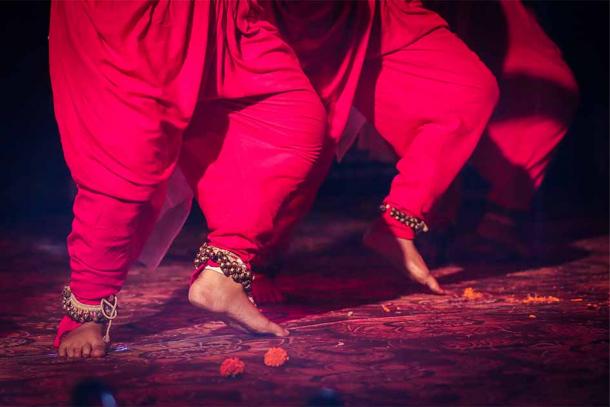
Detail of feet during indian sacred dance with musical anklet. (Arindam / Adobe Stock)
Pooja Kunitha:
This is a folk dance dedicated to Goddess Shakti. The dance involves the use of a square-shaped bamboo frame called the pooje, in which an idol of the goddess is embedded in the center. The poojari (male priest) performs this dance during religious festivals. Pooja Kunitha is characterized by vibrant movements, colorful costumes, and the expression of devotion to the divine feminine.
Sacred Dance in Hindu Rituals
The traditional Hindu dances, collectively known as the classical dance forms, stand as living embodiments of India's rich cultural heritage and spiritual depth. From the celestial grace of Bharatanatyam and the dramatic storytelling of Kathakali, to the divine devotion of Odissi and the mesmerizing charm of Mohiniyattam, each dance form resonates with profound meaning and artistic brilliance.
Rooted in ancient traditions, these sacred dances continue to enchant audiences worldwide, transcending time and borders. As the custodians of myth, folklore and religious tales, these dances represent the essence of Hindu mythology and serve as a timeless testament to India’s profound love for art, spirituality, and the divine.
Top image: Hindi culture is rich in traditions of sacred dance. Source: mihail / Adobe Stock
References
Editor. No date. “Indian Classical Dances” in Cultural India. Available at: https://www.culturalindia.net/indian-dance/classical/
Eldridge. A. 2013. “6 Classical Dances of India” in Encyclopedia Britannica. Available at: https://www.britannica.com/list/6-classical-dances-of-india
Narasingha. S. No date. “Katha Kali and Sacred Dance” in Gosai. Available at: https://gosai.com/writings/katha-kali-and-sacred-dance
Zubko. K. 30 October 2019. “Dance and Hinduism” in Oxford Bibliographies. Available at: https://www.oxfordbibliographies.com/display/document/obo-9780195399318/obo-9780195399318-0226.xml
















